Don’t restrict your knowledge of art to the Mona Lisa. Vatsala Chhibber introduces you to ten masterpieces that have emerged from the brushes of the world’s greatest artists
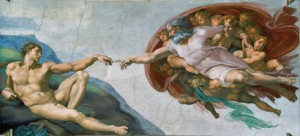 10. The Creation of Adam (1511-12)
10. The Creation of Adam (1511-12)
The master: Michelangelo
The ceiling of the Sistine Chapel, which is a collection of Biblical paintings (the most famous being The Creation of Adam) took Michelangelo four years to complete. “After four tortured years, more than 400 over life-sized figures, I felt as old and as weary as Jeremiah,” he wrote. In 1990, a physician named Frank Lynn Meshberger concluded that the imagery behind God in the painting is actually an anatomically accurate depiction of the human brain. This is not surprising as Michelangelo’s knowledge and fascination with the human anatomy was well-known. Some consider this addition to mean that intellectual abilities are a gift controlled by God.
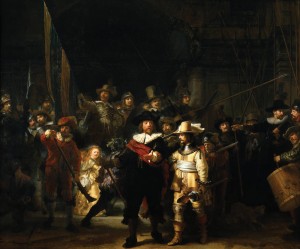 9. The Night Watch (1642)
9. The Night Watch (1642)
The master: Rembrandt van Rijn
The masterpiece: With his impressive use of colurs, Rembrandt creates an almost theatrical display of light and shadows in this painting, making it one of the most recognised works of art in the world. Though popularly known as The Night Watch, the painting’s actual name is The company of Captain Frans Banning Cocq and Lieutenant Willem van Ruytenburch preparing to march out, which also serves as its description.
 8. Impession, Sunrise (1872)
8. Impession, Sunrise (1872)
The master: Claude Monet
The masterpiece: Through this painting. Monet unwittingly gave birth to a new art movement. This style of painting with loose brush strokes and lack of detailing, though disregarded and criticised initially, was later given the term impressionism, borrowed from the name of this painting.
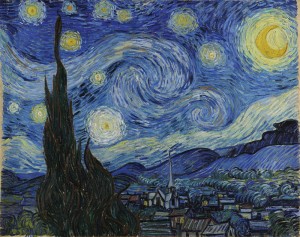 7. Starry Night (1889)
7. Starry Night (1889)
The master: Vincent Van Gogh
The masterpiece: The tumultuous mind of Vincent Van Gogh ultimately led him to a mental asylum where some of his greatest works, including Starry Night, were born. The artist, who is infamous for cutting off a part of his ear, painted this dramatic piece from memory: his interpretation of the starry sky he witnessed the previous night. Sadly, success eluded Van Gogh in his lifetime as he sold only one painting while alive.
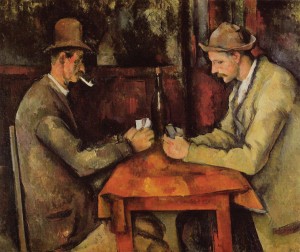 6. The Card Players (1892)
6. The Card Players (1892)
The master: Paul Cezanne
The masterpiece: This postimpressionist painter has been referred to as “the father of us all” by Pablo Picasso. Cézanne’s The Card Players (one of a series of -)ve paintings) made news last year, when it was bought at an auction for US$250 million, making it the most expensive painting ever sold.
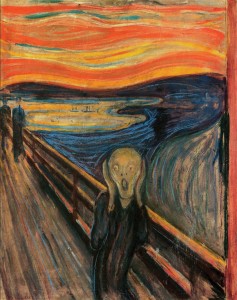 5. The Scream (1893)
5. The Scream (1893)
The master: Edvard Munch The masterpiece: This painting is a prominent example of expressionism where art is used primarily to convey an emotion, mood or idea. The emotion that inspired The Scream has been summarised by Munch in a diary entry: “One evening I was walking along a path, the city was on one side and the fjord below. I felt tired and ill. I stopped and looked out over the fjord – the sun was setting, and the clouds turning blood red. I sensed a scream passing through nature; it seemed to me that I heard the scream. I painted this picture, painted the clouds as actual blood. The colour shrieked. This became The Scream.”
 4. The Kiss ( 1907-1908)
4. The Kiss ( 1907-1908)
The master: Gustav Klimt
The masterpiece: It is suggested that the lovers in the The Kiss are Klimt and his companion Emile Floge. This is also his most significant work from his ‘golden phase’ where he employed the use of gold leaf to gild his paintings. In fact, certain art historians believe the title of the greatest painting of all time lies with The Kiss because unlike the Mona Lisa, it does not leave you underwhelmed when you are confronted by it. Instead, it draws you in to an intriguing and aesthetic moment shared by two lovers.
 3. Three Musicians (1921)
3. Three Musicians (1921)
The master: Pablo Picasso
The masterpiece: Picasso, along with his contemporary Georges Braque, gave birth to a form of art called Cubism, which uses geometric figures and shapes to give you a multi-layered perspective, though one angle. The three musicians in the painting are said to be Picasso and his friends Guillaume and Jacob. While cubism paintings look like the creation of someone with distorted vision, on close observation you will notice different angles, layers and elements gradually emerging from the piece. For example, in this painting, did you notice the dog seated under the table?
 2. The Persistence of Memory (1931)
2. The Persistence of Memory (1931)
The master: Salvador Dali
The masterpiece: You can credit the dream-like imagery in Dali’s works to the art movement of surrealism. There have been many interpretations of this painting, but none that the artist has confessed to. Do the melting watches signify how time loses its rigidity and form in a dream? Is the fleshy creature lying in the painting a profile of Dali’s face? The answers can only lie in the eyes of the beholder.
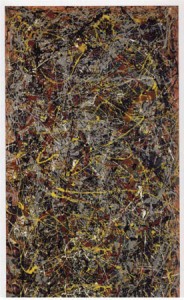 1. No. 5, 1948 (1948)
1. No. 5, 1948 (1948)
The master: Jackson Pollock
The masterpiece: Why would paint splatter on canvas fetch US$140 million at an auction, you ask? Well, Pollock used a technique called ‘action painting’ where his entire body was involved in creating this masterpiece; hands, toothbrushes, syringes, paint spills, all came together to create this chaotic piece. In a letter, Pollock states, “When I am painting I am not much aware of what is taking place – it is only after that I see what I have done.”
The Indian Masters
“I can only paint in India. Europe belongs to Picasso, Matisse, Braque… India belongs only to me.” – Amrita Sher-Gil
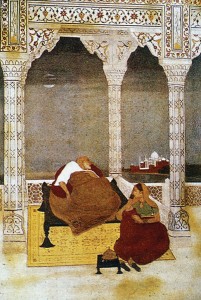 Abindranath Tagore
Abindranath Tagore
The masterpiece: The Passing of Shah Jahan (1902)
Rabindranath Tagore’s nephew Abindranath was a pivotal figure in the Indian modern art movement. He modernised Mughal and Rajput painting styles (as can be seen in The Passing of Shah Jahan) and later infused Japanese and other East Asian influences in his work, thereby staying away from European influences that were prominent at the time. Tagore also trained and inspired several prominent Indian artists such as Nandalal Bose and Jamini Roy, who were his students.
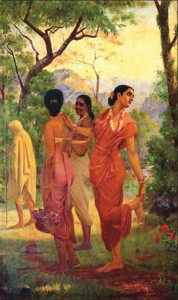 Raja Ravi Varma
Raja Ravi Varma
His masterpiece: Shakuntala (1870)
Many of Raja Ravi Varma’s iconic paintings capture moments between mythological lovers Shakuntala and Dushyant. In this particular painting, in order to dodge the prying eyes of her friends, Shakuntala pretends to remove a thorn stuck in her foot while searching for her lover Dushyant. Varma’s work is a stunning amalgamation of Indian subjects and European technique (he was trained by a Dutch artist). His paintings found international acclaim and won him several awards and honours.
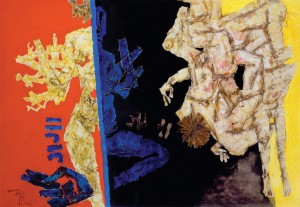 M F Hussain
M F Hussain
His masterpiece: Battle of Ganga and Jamuna: Mahabharata 12 (1971-72)
This painting, which fetched a record-breaking US$1.6 million at a Christie’s auction, is inspired by the Mahabharta (Hindu mythology was a frequented theme in Hussain’s art) and depicts the battle between good and evil. Popularly known as the ‘Picasso of India’, (cubism techniques are apparent in his style) Hussain’s nude portraits of Hindu gods and goddesses caused intense displeasure among some communities who filed cases against him for hurting religious sentiments. The artist ultimately lived in self-imposed exile till his death in 2011.
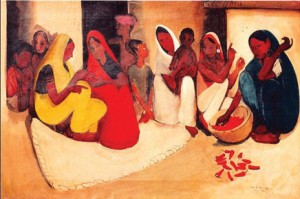 Amrita Sher-Gil
Amrita Sher-Gil
Her masterpiece: The Village Scene (1937)
In her brief 28 years, Amrita Sher-Gil rose to prominence in the Indian and international art community. Her painting Village Scene, which is a depiction of rural life (inspired by her stay at an estate in Uttar Pradesh), also made her the most expensive female artist in India when it sold for `6.9 crore. Though she studied in Paris and was influenced by European artists, her heart remained with India and Indian themes. She said, “I can only paint in India. Europe belongs to Picasso, Matisse, Braque… India belongs only to me.”
Volume 3 Issue 4




























